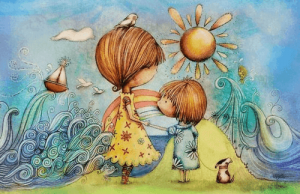Be Your Child's Shield While Forging a Warrior


Reviewed and approved by the psychologist María Alejandra Castro Arbeláez
It is inevitable that we’ll see our children fall on different occasions throughout their childhood. It is essential to become your child’s shield so that they can overcome difficult circumstances while developing the tools to become a true warrior in the future.
Have you ever experienced that horrible feeling when your child is hurt or rejected in different ways? Blows, hurtful words, rejected love and academic failures often bring a child’s self-esteem to the ground. Give them wings to rise to the highest peak. That is your task as a parent.
The injustices of daily life touch the deepest fibers of every being. That is why it is fundamental to be the protector of these infants, making you your child’s shield until he can defend himself with his own claws.
Be your child’s shield until a warrior is born
When it comes to bullying or academic failures, you should not let time go by. Many children cannot wait for adults to take action on the matter since, after successive abuses, it may be that waiting means despair. Of course, in many instances, this is not just “children being children.”
Every parent has the responsibility to forge a personality capable of facing the onslaughts of daily life, but it will first be necessary to shield your child. It is imperative to ensure that children coexist and develop in safe environments.

Of course, if you believe that your child is in danger or is affected for some reason, it is best to take action on the matter as soon as possible. To do this, you have a host of alternatives that you can apply to create a future fighter.
How to become your child’s shield
Of course, some of the conflicts of daily life that your child faces require the intervention of an adult in order to solve the problem at its roots. To become your child’s shield in order to feed his inner warrior, you simply have to empower him.
This empowerment will allow the child to face the situation to solve it in the most correct way. But what does this mission consist of?
- Teach him to love himself. The idea is then to promote his self-esteem and security so that he feels both valuable and valued.
- Teach him to impart respect and to set limits. Ideally, your child will know how to take control of a situation, say no and express his rights in an assertive way. For this, it is possible to perform a series of useful practice exercises where the child will gain more confidence.

- Let him learn to ask for help. It is not necessary to solve absolutely everything alone, because children can learn to solve conflicts by watching the way older people act. In this case, getting an adult is not bad, but rather quite the opposite.
- The importance of using one’s voice. If the child wishes to feel respected, he must learn to use his voice to defend himself or others when he understands that they are in unfair situations. For this reason, sometimes, the use of this physical instrument becomes vital, as is the strength to avoid certain extreme situations such as sexual abuse or physical aggression.
Being your child’s shield is investing in the future
We are not talking about over protection, but advise simply paying attention in order to provide the necessary tools and instruments so that your child can calmly face any adverse situation in the future.
All you need is love, because that allows you to sow the seeds of security, self-esteem and self-confidence. Once these invaluable fruits are harvested, your child will have a sense of what he is worth as a person, and will thus raise his head to face any battle.
You will be there to see your great little fighter stand up to face his first challenges, with the aim of avoiding all kinds of obstacles that get in the way of his path. Don’t let go of his hand.
All cited sources were thoroughly reviewed by our team to ensure their quality, reliability, currency, and validity. The bibliography of this article was considered reliable and of academic or scientific accuracy.
- Bowlby, J. (1986). Vínculos afectivos: formación, desarrollo y pérdida. Madrid: Morata.
- Bowlby, J. (1995). Teoría del apego. Lebovici, Weil-HalpernF.
- Garrido-Rojas, L. (2006). Apego, emoción y regulación emocional. Implicaciones para la salud. Revista latinoamericana de psicología, 38(3), 493-507. https://www.redalyc.org/pdf/805/80538304.pdf
- Marrone, M., Diamond, N., Juri, L., & Bleichmar, H. (2001). La teoría del apego: un enfoque actual. Madrid: Psimática.
- Moneta, M. (2003). El Apego. Aspectos clínicos y psicobiológicos de la díada madre-hijo. Santiago: Cuatro Vientos.
This text is provided for informational purposes only and does not replace consultation with a professional. If in doubt, consult your specialist.








